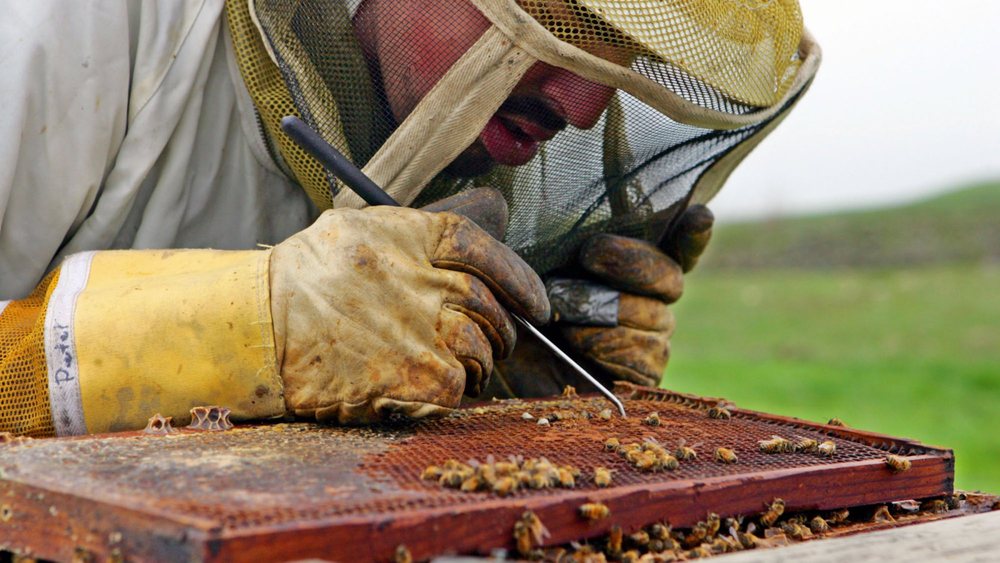Eye | Neonics & Honeybees | Bee Friendlier Flower Bombing | Whole Foods For Honeybees
/
A Bee Friendlier Flower Bombing
The Importance of Bees
One in three bites of food1 is made possible by bees and other pollinators . Bees pollinate nearly two-thirds of major U.S. crop species. We can thank bees for coffee, chocolate, tomatoes, cotton and more. Bees are also vital to clover and alfalfa: two crops that feed cattle and other grazing animals. In the United States alone, over one hundred crops need or benefit from bees, which translates to $3 billion of our economy.
Pollinators are also essential to other animals. Many fruits and seeds need pollinators to grow and survive – plants that feed a quarter of all birds and several mammal species. via Cascadian Farm Organic

Scientists may have finally solved mystery behind honey bee decline St George News (Utah)
Deeply moved by the Flower Bombing video from Cascadian Farm Organic, it’s time to update ourselves the global problem of a drastic decline in honey bees, known as colony collapse disorder. (Note, you will soon read that this perception of a serious problem is challenged. )
AOC has a long history of writing about this deeply concernful problem, with major implications for the global food supply and food prices in poor countries and right here in America. The world is united in the disastrous consequences resulting from the loss of our honeybees … or are we?
Fifty years ago, Albert Einstein said:
“If bees were to disappear from the globe, mankind would only have four years left to live.”
In discussing this (perceived) grave problem with readers, AOC turns to the deeply Republican state of Utah and their assessment of the June 24, 2013 statement issued by the Task Force on Systemic Pesticides, a group of international scientists formed in response to concern around the impact of systemic pesticides on biodiversity and ecosystems.
Task Force on Systemic Pesticides
A comment on the article from St George News refers readers to Henry I. Miller’s WSJ article Why the Buzz About A Bee-pocalypse Is a Honey Trap. Note the article lives behind a paywall, but you can read it via Google as a free sample. Miller writes:
The reality is that honeybee populations are not declining. According to U.N. Food and Agriculture Organization statistics, the world’s honeybee population rose to 80 million colonies in 2011 from 50 million in 1960. In the U.S. and Europe, honeybee populations have been stable—or slightly rising in the last couple of years—during the two decades since neonics were introduced, U.N. and USDA data show. Statistics Canada reports an increase to 672,000 honeybee colonies in Canada, up from 501,000, over the same two decades.
In February, the Australian government issued a report on bee health from the only continent unaffected by the Varroa destructor mite, a pathogen of bees. It found that, “Australian honeybee populations are not in decline, despite the increased use of [neonicotinoids] in agriculture and horticulture since the mid-1990s.”
 I am admittedly shocked over the level of disagreement around whether or not there is a problem with honeybee decline. Somebody can’t count!!! The discussion quickly devolves both on the St George News website and the Wall Street Journal into anti-Obama rhetoric, global warming skepticism, more government regulation arguments, and calling people ‘communists’.
I am admittedly shocked over the level of disagreement around whether or not there is a problem with honeybee decline. Somebody can’t count!!! The discussion quickly devolves both on the St George News website and the Wall Street Journal into anti-Obama rhetoric, global warming skepticism, more government regulation arguments, and calling people ‘communists’.
The same kind of gridlock that exists in Washington DC exists in editorial pages and their comments sections. What is a thinking person to do!!!! I do know that AOC readers are not ‘communists’ because we are trying to understand a potentially serious problem like the health of honey bees and its impact on the global food supply.
While disagreement exists around the scope of honeybee decline from minimal to gravely concerning, my single takeaway from reading both sides of the argument is that the decline is not the result of a single factor. All agree that the Varroa destructor mite is highly destructive to honeybee population, for examples.
Miller continues:
In February, the Australian government issued a report on bee health from the only continent unaffected by the Varroa destructor mite, a pathogen of bees. It found that, “Australian honeybee populations are not in decline, despite the increased use of [neonicotinoids] in agriculture and horticulture since the mid-1990s.”
A 2013 European ban on the use of neonic pesticides will provide some quantifiable results, as will the partial ban in the Philippines. The US Fish and Wildlife Service’s National Wildlife Refuge System will phase out or neonics, aka neonicotinoids, by 2016. The same US ban includes GMO seeds being fed to wildlife.
Whole Foods Initiative For the Honeybees
Whole Foods Market (and its libertarian, anti-Obama CEO and co-founder John Mackay) post a figure of 29.6% as the annual US rate of US honey bee losses. Whole Foods agrees that multiple factors — including parasites, pesticides and loss of habitat — contribute to this decline.
AOC wrote recently about Whole Foods’ new Responsibly Grown rating system.
There is a real emphasis on protecting bees, and the program prohibits the use of several of the most hazardous neurotoxins still allowed in agriculture, including the four primary neonicotinoid pesticides (clothianidin, dinotefuran, imidacloprid, and thiamethoxam) linked to bee declines. Clearly, this is a major issue facing the world, and the discussion will be continued … On a more positive note …
Inspiring & Empowering Flower Bombing Guerilla Messaging
Flower Bombs from MCreative on Vimeo.
Flower Bombs is a guerrilla art initiative that explores the karma and power of public art through positive messaging. The symbol of the flower growing out of a bomb represents beauty in unexpected places — which is what street art is all about.
The idea was to get the messages out there in a way that is not toxic to the environment. Wheat paste is an environmentally non-acidic way of posting these messages. It is easy to remove and breaks down over time so naturally it felt like the best option.
The reason we cover our faces is because we don’t want to be the sole artists identified with the Flower Bombs project. We want other people to take part in it as well; so it’s not so much us hiding our identities as much as it is a representation of the fact that anyone can be the face behind the mask. Anyone can be a “Flower Bomber.”
In a world where we are constantly bombarded with advertisements of the media, sometimes against our will, it is nice to come across a design that isn’t trying to sell us anything. Something that serves as a balm to our spirit and that speaks to us on a non-consumer level.
The goal of the project is to fill the world with positive affirmations through beautiful non-commercial design for no reason other than to make people feel good and to help them manifest positive life changes. We imagine a world where people are surrounded by more beauty and art than consumerist messages.
We encourage you to print the posters and paste them in your own city. First, save and print the individual posters in Downloads, where you can also quickly learn how to make wheat paste. Last, buy paint rollers, hit the town, and enjoy Flower Bombing!
Flower Bombing Copenhagen with DoTheUnexpected.org
Previously on Anne of Carversville
‘More Than Honey’ Bee Documentary Focuses On Sex Lives of Queen Bee Where More Is Better AOC Salon
Will Sarah Burton’s Queen Bee Femme Fatales Suffer in Collapse of Global Honey Bee Populations? AOC Salon (a major composite of bee-related research and articles)


